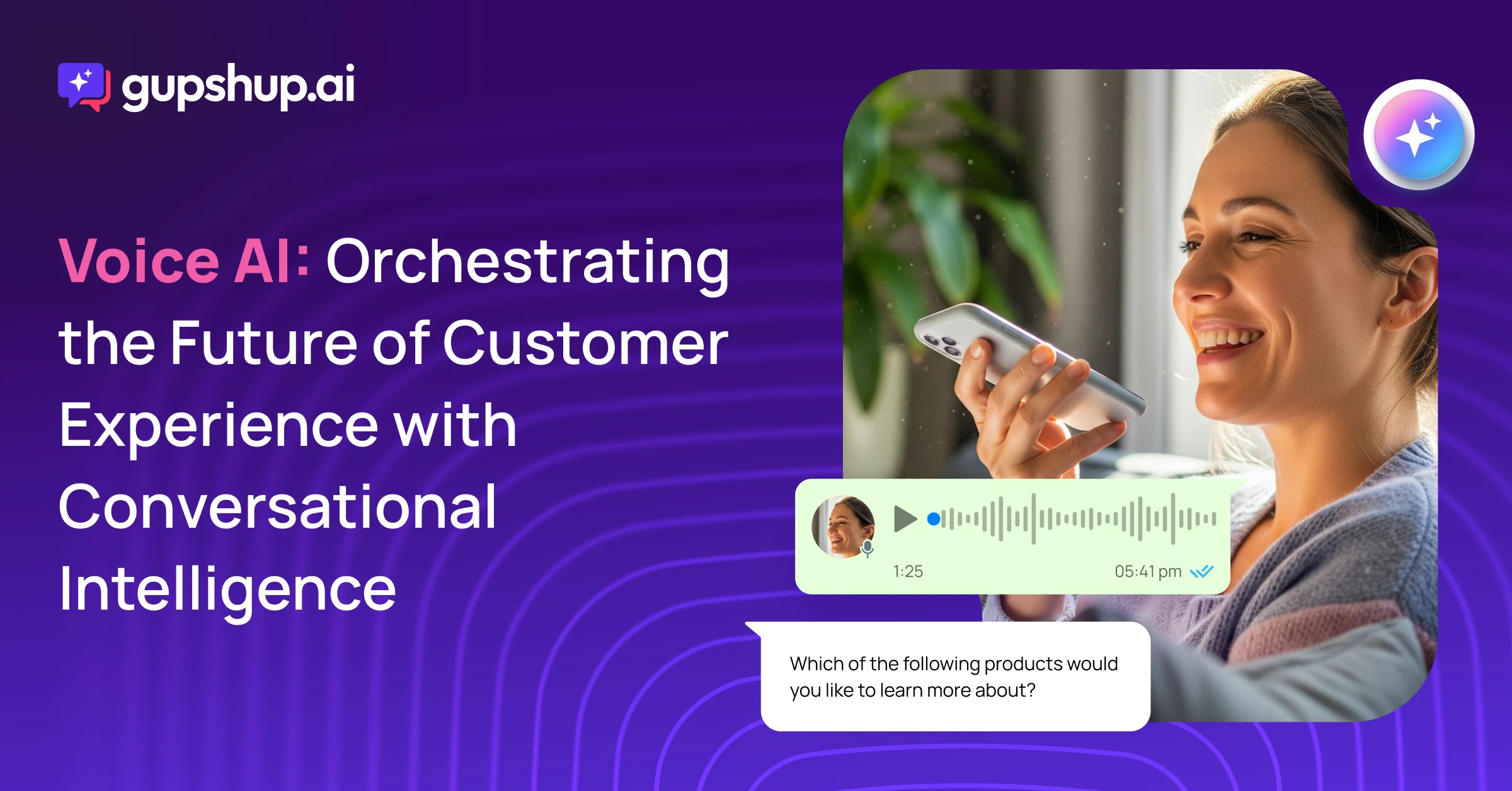Voice AI: Orchestrating the Future of Customer Experience with Conversational Intelligence

See the power of intelligent conversations for your brand.
The landscape of customer experience (CX) and by extension, the modern contact centre is rapidly evolving, driven by breakthroughs in artificial intelligence. While Agentic AI promises autonomous problem-solving in the future, Voice AI is already leading a parallel and equally transformative shift today: enabling natural, intuitive, and highly efficient voice-based interactions at scale.
For contact centre leaders, this is far more than an upgrade to traditional IVR. Voice AI represents a new generation of intelligent systems that can understand customers, infer intent, and respond dynamically — reducing handle times, improving containment, and empowering agents with context rather than replacing them outright.
Recent studies indicate that voice interactions are set to account for a growing share of all customer service touchpoints over the next few years. This trend highlights the strategic imperative for contact centres to move beyond siloed call routing and static scripts, and instead embrace sophisticated Voice AI capabilities that deliver end-to-end conversational intelligence from first contact to resolution.
The Technical Anatomy of Advanced Voice AI
At its core, a robust Voice AI system for customer experience is a complex orchestration of several key technical components:
- Advanced Automatic Speech Recognition (ASR): This foundational layer is responsible for accurately converting spoken language into text. Modern ASR systems leverage deep learning models, often recurrent neural networks (RNNs) or transformer architectures, trained on massive datasets of diverse accents, speech patterns, and background noises. Key technical considerations include:
- Acoustic Modeling: Mapping acoustic signals to phonemes or sub-word units.
- Language Modeling: Predicting sequences of words based on grammatical and contextual probabilities.
- Noise Robustness: Algorithms for filtering out environmental noise and handling varying audio quality.
- Speaker Diarization: Identifying and separating different speakers in a conversation.
- Natural Language Understanding (NLU): Once the speech is transcribed, NLU takes over to comprehend the user’s intent, extract critical entities, and identify the semantic meaning of the query. This involves:
- Intent Recognition: Classifying the user’s goal (e.g., “check balance,” “reset password”). This often employs sophisticated classification models, or fine-tuned large language models (LLMs).
- Entity Extraction (Named Entity Recognition – NER): Identifying key pieces of information within the utterance (e.g., account numbers, dates, product names). Conditional Random Fields (CRFs) and Bi-directional LSTMs with CRFs are common architectures here; however, they’re increasingly being replaced by transformer-based models.
- Sentiment Analysis: Gauging the emotional tone of the user’s speech, which can inform the agent’s response strategy.
- Dialogue Management: This is the “brain” of the Voice AI, responsible for maintaining the conversational flow, tracking context, and deciding the next best action. It involves:
- State Tracking: Keeping track of the current state of the conversation, including previously extracted information and user preferences.
- Dialogue Policy: Determining the agent’s response based on the current state and NLU output. Reinforcement learning (RL) is increasingly used here to learn optimal conversational policies from user interactions.
- Contextual Memory: Storing and retrieving past conversational turns to ensure coherence and personalize interactions. This often involves vector databases and retrieval augmented generation (RAG) techniques to integrate external knowledge bases.
- Natural Language Generation (NLG): The final step in generating a human-like response in text format. Modern NLG leverages advanced generative models, including fine-tuned LLMs, to create grammatically correct, contextually relevant, and natural-sounding replies.
- Text-to-Speech (TTS): Converts the generated text response back into high-quality, synthetic speech. Cutting-edge TTS systems employ deep neural networks (e.g., Tacotron, WaveNet, VITS) to generate highly natural and expressive voices, often with customizable voice profiles and emotional inflections.
- Integration with Enterprise Systems (Tool Calling): For a Voice AI to be truly effective, it must seamlessly integrate with backend systems such as CRM, ERP, knowledge bases, and billing systems. This “tool calling” or “function calling” capability allows the Voice AI to retrieve real-time data, execute transactions, and provide accurate, up-to-date information to the customer. This often involves APIs, microservices, and secure authentication protocols.
- Guard-Rails and Compliance: Ensuring that the Voice AI operates within defined ethical, legal, and brand guidelines is paramount. This involves:
- Content Filtering: Preventing the generation of inappropriate or harmful responses.
- Data Privacy Mechanisms: Adhering to regulations like GDPR and CCPA in handling sensitive customer data.
- Brand Voice Adherence: Ensuring the generated responses align with the company’s communication style and tone.
Transformative Value of Voice AI in Customer Experience
Implementing an advanced Voice AI solution offers significant advantages for businesses:
- Automated Lead Generation & Qualification at Scale:
Voice AI handles large volumes of inbound enquiries, identifies high-intent prospects through conversational cues, and qualifies them in real time. It routes only hot leads to sales agents while nurturing the rest autonomously. - Seamless Self-Service and Transaction Completion:
Customers can resolve routine Level-1 queries, book appointments, check order status, make payments, and even complete purchases through natural voice interactions. This reduces agent load and accelerates conversions. - Personalised Cross-Sell & Upsell in Real Time:
By leveraging contextual memory and CRM integration, Voice AI dynamically recommends relevant products or upgrades during service calls, turning support conversations into revenue-generating opportunities. - Smart Escalation for Human-AI Collaboration:
For complex or emotional cases, Voice AI provides instant summaries and context to live agents, ensuring smooth handoffs that boost first-call resolution (FCR), CSAT and sales closure rates. - Loyalty-Driving, Emotionally Intelligent Engagement:
By understanding sentiment and past behaviour, Voice AI delivers empathetic, on-brand interactions that strengthen long-term relationships and reduce customer churn. - Revenue-Focused Operational Efficiency:
Automating repetitive tasks frees human agents to focus on high-value moments. This improves productivity while directly impacting pipeline growth, conversion speed and customer lifetime value.
The Future of Voice AI: Beyond Conversations
The evolution of Voice AI is accelerating, promising even more sophisticated capabilities:
- Multi-Modal Intelligence: Integrating voice with other modalities like visual cues (e.g., screen sharing in video calls) for a richer, more contextually aware interaction.
- Predictive and Proactive Voice Agents: Leveraging predictive analytics to anticipate customer needs and initiate conversations or offer solutions before the customer even articulates a problem.
- Autonomous Learning and Adaptation: Voice AI systems will continually learn from new interactions, refining their NLU, dialogue management, and response generation capabilities with minimal human intervention.
- Emotional Intelligence: More sophisticated understanding and generation of emotional nuances in voice, allowing for more empathetic and human-like interactions.
- Personalized Voice Biometrics: Secure and seamless authentication through voice recognition, further streamlining customer journeys.
Voice AI is rapidly moving from a supportive technology to a core strategic asset for customer experience. Businesses that embrace and technically master these advanced Voice AI capabilities will not only optimize their operations but also forge deeper, more meaningful connections with their customers, truly orchestrating the future of conversational intelligence.
The question isn’t whether to adopt Voice AI, but how quickly you can implement it to stay ahead of evolving customer expectations. As the technology continues to mature, early adopters are already seeing transformative results — from 40% reductions in average handle time to 60% improvements in first-call resolution rates.
Ready to Transform Your Customer Experience with Voice AI?
Don’t let your competition lead the voice revolution. Discover how Gupshup’s enterprise-grade Voice AI platform can help you deliver exceptional conversational experiences at scale. Our advanced solution combines cutting-edge ASR, NLU, and dialogue management capabilities with seamless enterprise integrations — all designed to work within your existing infrastructure.
Join leading brands who are already using Gupshup to automate millions of voice interactions while maintaining the human touch that customers value. Schedule a demo today and see how Voice AI can transform your contact center operations. Click Here.



 +91-9355000192
+91-9355000192 Login
Login





